Inside the Evil Axis
Bomb blasts, streaming-propaganda and a mock internet, deserted streets and stark countryside typify what is nonetheless the world's biggest worry. Yet a tour of the pitiful "People's Paradise" reveals a bankrupt regime desperately wielding absurd Weapons of Mass Deception.
By Ron Gluckman /Pyongyang and around North Korea
KIM JONG-IL IS GONE, DEPOSED, overthrown in a huge uprising. Or soon will be.
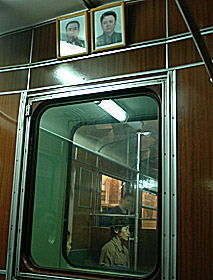 The Dear Leader’s portrait has been pulled down from buildings across North
Korea. A coup is imminent, or already underway. And that explosion at the train
station near the Chinese border? An assassination attempt! Hence, this
secrecy-obsessed state has outlawed mobile phones.
The Dear Leader’s portrait has been pulled down from buildings across North
Korea. A coup is imminent, or already underway. And that explosion at the train
station near the Chinese border? An assassination attempt! Hence, this
secrecy-obsessed state has outlawed mobile phones.
Such is the news – or more accurately, speculation – published in the weeks prior to my visit in the fall of 2004. None proves true, except for the last bit, which I verify, sadly, first-hand.
Shortly after landing at Pyongyang International Airport, I’m dispatched with a Nigerian diplomat to a rack of tiny cubbyholes. We’re issued small, numbered socks. Our mobile phones are stuffed inside.
Neither of us had any connection to the train blast months before. Nor, did our phones (which we reclaim upon check-out from this People’s Paradise).
Yet reports placed North Korea’s reclusive leader on a train returning from China at a time close to the explosion. Then, months later, North Korea abruptly ended its brief experiment allowing mobile phones.
Connect the dots - many reporters did: a cell-phone conspiracy nearly claimed Dear Leader.
Such innuendo, irresponsible in the extreme, is the style of North Korea’s own preposterous propaganda sheets. Yet single-source stories, or obscure hearsay, also fills reputable publications, shaping what the world comes to know – and misunderstand about the Hermit Kingdom.
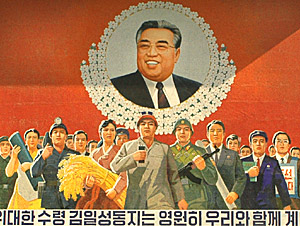 Getting credible information from a largely sealed-off, xenophobic,
censorship-crazed state is nearly impossible. Still, matters aren’t helped by
the fact that nowhere else the size of Mississippi is so often in the news, so
regularly written about by people who have never visited.
Getting credible information from a largely sealed-off, xenophobic,
censorship-crazed state is nearly impossible. Still, matters aren’t helped by
the fact that nowhere else the size of Mississippi is so often in the news, so
regularly written about by people who have never visited.
I didn’t assume to address this shortcoming, as I began preparing for my visit. Still, besides peaking into dark corners and talking to as many local people as possible, I did hope to tackle some major questions.
Friends repeated them as I packed: Is it really an Axis of Evil? Do they have the nuclear bomb? Is Kim Jong-Il genuinely popular, or headed for a fall? And – from Americans - what do North Koreans really think of us?
Call it my hidden agenda. Practically everyone I encountered in the secretive state seemed to have one. My visit coincided with the Pyongyang International Film Festival, which seemed an opportune time to not only get lost in a crowd, but mingle with a cross-section of potential sources: visiting dignitaries, foreign diplomats, culture-starved North Korean aid workers, plus whatever passed for the Pyongyang coffee-house crowd.
Lacking an invite, I crashed the festival as a German film buff from Hong Kong. Held every two years, the world’s most unlikely film festival long celebrated socialist values and Cold War camaraderie. The first winner was "The Shrapnel," a Libyan love tale: boy meets girl, she’s killed by imperialist-laid mines; rushing to her aid, he dies in the explosion.
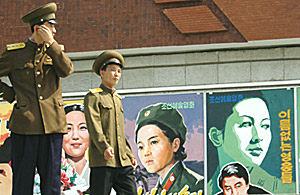 Broadening the fare is one sign of openness in the world’s most reticent
regime. Nearly 100 films from 50 countries were shown, including "Bend It
Like Beckham" the first commercial western ever screened here.
Broadening the fare is one sign of openness in the world’s most reticent
regime. Nearly 100 films from 50 countries were shown, including "Bend It
Like Beckham" the first commercial western ever screened here.
Although light comedy, this coming-of-age football film seemed revolutionary in a state that bans videos and satellite dishes, offering only propaganda on the sole state-run television station. North Koreans viewed novel themes: sexism, racism, and the conflict between tradition and modernization.
Yet no chuckles greeted some jokes, like one comical lesbian allusion. Perplexed, I queried my guides, finding they had no clue what I was talking about.
State censors seemed at work. All films were dubbed live in Korean. Movies had to be submitted in advance so socially-acceptable scripts could be prepared.
I boasted of the scoop at the nightly meeting hole, the pool hall and bowling alley beside the Nevada slot machines in the basement of the Yanggakdo Hotel, where the entire film entourage was cloistered.
A visiting director insisted I was wrong. For proof, he deferred to a fellow European filmmaker. "He caught everything."
Astonished, I asked his colleague: "You speak Korean?" Sheepishly, glancing at walls assumed to have ears, he whispered, "Not officially."
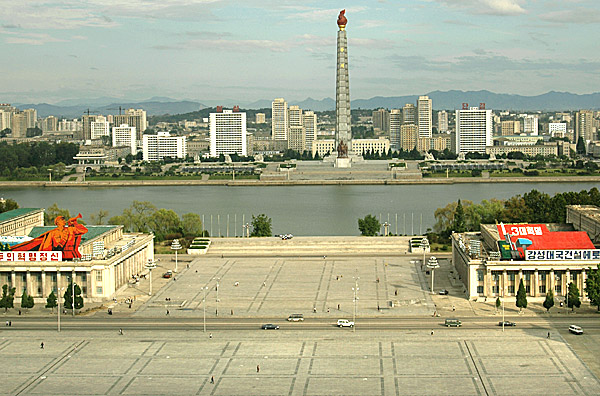
Pyongyang is ideally suited to cloak-and-dagger routines with its bizarre sound stage of sweeping Stalinist-style architecture, vast plazas and monumental statues.
The skyline is lit by Tower of the Juche Ideal, a torch-topped 170-meter obelisk (tipping the Washington Monument by one meter), while views are dominated by the lurking, pyramid-shaped Ryugyong Hotel, at 105 stories, the world’s tallest.
Or it would if completed. Launched after South Korean started work on a tall Singapore hotel, the Ryugyong stalled in the 1980s and remains a concrete-shell absurdity.
But it has heaps of company, from the kitsch cone-shaped ice skating rink to endless colonnaded museums devoted to victories over various imperialistic forces: the Japanese, South Koreans and, mostly, the Americans.
The Victorious Fatherland Liberation War Museum is typical, its 52,000 square meters crammed with horrifying, graphic displays of atrocities committed by American forces and their puppet stooges, as the Koreans in the south are called.
The exhibits included melted tanks, downed planes and an entire room detailing American use not only of biological, but also bug warfare. Photos of insect agents are posted beside confessions from captured pilots, detailing a scheme to infect North Korea with poison pests.
 Room after room is filled with such vindictive, running the gamut from
foreign missionaries torturing local civilians to soldiers burning Koreans alive
in graphic depiction.
Room after room is filled with such vindictive, running the gamut from
foreign missionaries torturing local civilians to soldiers burning Koreans alive
in graphic depiction.
The centerpiece is a huge diorama on an entire floor, recreating the battle of Taejon, probably America’s biggest defeat in the Korean War. Using a mix of painted scenes and figurines, the 360-degree, 3-D representation is a magnificent display of an old art form lost to the world, along with one finely honed here - government propaganda.
Newcomers might be gripped by the barrage of brainwashing, but in reality, North Korea’s lies and distortions have been tuned down. Realizing this requires perspective. To my deception as an undercover American who slept through many films, can be added another secret: I was here before.
Thirteen years previously, I took a rare tour of the Hermit Kingdom. Just how rare my guide at the time revealed, when he conceded he had never met an American visiting his country as a tourist. Yet, his card identified him as head of American tourist services, a post he had already held for nine years.
Back then, Mr. Li proudly swept me through sites designed to showcase North Korea’s role as a world power. All would seem laughable displays of insecurity to any outsider, but Mr. Li was a true believer.
 At the Juche Tower, he pointed out marble plaques from study
associations around the world dedicated to Juche, the philosophy of
self-reliance concocted by original dictator Kim Il-Sung (even as North Korea
has been kept afloat all these decades by Russia and China).
At the Juche Tower, he pointed out marble plaques from study
associations around the world dedicated to Juche, the philosophy of
self-reliance concocted by original dictator Kim Il-Sung (even as North Korea
has been kept afloat all these decades by Russia and China).
When he merrily noted a New York society, I exploded: "Rubbish. Nobody outside North Korea has ever heard of Juche." Mr. Li’s jaw dropped, his entire world deflated.
Nowadays, North Korea has moved on from such nonsense. Understand, Kim Jr and his cohorts continue to project images of a dangerously defiant, nuclear-wielding world force. Residents still swallow the baloney – what choice do they have? – but are outspokenly and irreverent, no longer pretending that it satisfies. Or that electricity works. Or, on average wages of $6 a month, there is real meat rather than the government baloney on the table.
Take tours of the Demilitarized Zone, the imaginary line that bisects the Korean peninsula, a gaping wound that has divided the Land of Morning Calm for half a century. On previous visits, this seemed not only the last front of the Cold War, but the frontline of one-upmanship, a paradise of propaganda, on both sides.
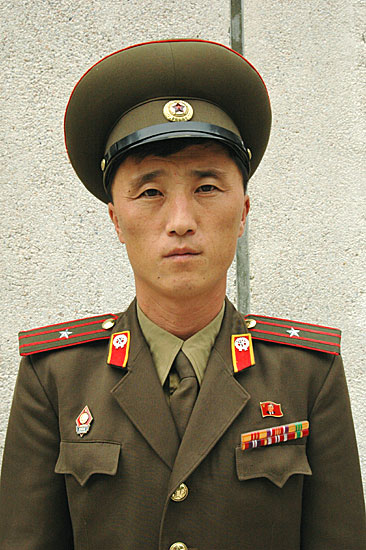 As stern soldiers from the north and south faced off in tense poses
around the truce table, the world’s biggest flagpoles rose across the line,
taller on one side, bulkier on the other. Loudspeakers blared North Korean
propaganda from Kijongong (Peace Village), a tiny town encircled by barbed wire.
On the south, a mirror town is called Freedom Village, even though residents are
locked down after dark.
As stern soldiers from the north and south faced off in tense poses
around the truce table, the world’s biggest flagpoles rose across the line,
taller on one side, bulkier on the other. Loudspeakers blared North Korean
propaganda from Kijongong (Peace Village), a tiny town encircled by barbed wire.
On the south, a mirror town is called Freedom Village, even though residents are
locked down after dark.
Now, guards watch guests from alternate sides, staggered to avoid potentially-explosive confrontations. Gone are loudspeakers and flags. On the Reunification Highway from Pyongyang to the border at Panmunjom (signposted to Seoul, only 70 kilometers further) my guide points out warehouses and fleets of trucks along the roadside. "Those are South Korean conveys," he says, "bringing rice."
Such admissions, suggesting any North Korean weakness or shortcoming, would have been unthinkable before, but Mr. Kim matter-of-factly discusses the crippling famine that forced North Korea to accept food aid, including rice from the south. With the assistance has come greater cooperation, including big tourist projects. And perhaps North Korea’s oddest joint venture, production of its first car.
The Whisper was supposed to signal a roll out of commerce in North Korea. You cannot fail to notice Whisper billboards, since they are the only ones you see in the entire country. Other than the garish pop-art posters declaring the glories of the Great Leader. Otherwise, not a single advertisement or stick of neon.
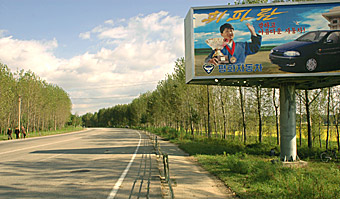 But you won’t spot many Whispers either. Mr. Kim insists the car is
selling well, but simply cannot point one out on a day’s drive. Every couple
hours, I remind him. "Any Whispers along this road?" Or, "Don’t
forget to point out that car."
But you won’t spot many Whispers either. Mr. Kim insists the car is
selling well, but simply cannot point one out on a day’s drive. Every couple
hours, I remind him. "Any Whispers along this road?" Or, "Don’t
forget to point out that car."
He remains silent; not a whisper that day. The next morning, minutes after setting off, he signals ahead. "Look, there’s a Whisper." It’s the only one I ever see on my eight-day tour. Except on the billboards, overlooking empty streets.
Starkness distinguishes Pyongyang, with an almost surreal absence of people, cars or commerce. Still, there are a few barber shops, restaurants and stores stocking genuine goods.
Thirteen years ago, doors were chained shut, shops vacant save for stacks of fruit propped against windows by plywood sheets, to fool observers into thinking produce was plentiful. On my previous visit to a department store, I watched people come and go for half an hour, but nobody bought anything, like actors in some huge theater of the absurd.
Pyongyang could still serve as the set for a science fiction film, kind of "The Day After," only a neutron-bomb edition. The lack of activity was stunning. One sunny afternoon following several days of rain, the river running through Pyongyang was deserted.
No boats treaded the water, no sunbathers lay along the shores. From the Grand People’s Study House, perched atop Nam Hill, I looked past massive Kim Il Sung Square, all the way over Taedong River to the plazas surrounding the Juche Tower and saw not a single pedestrian or car pass.
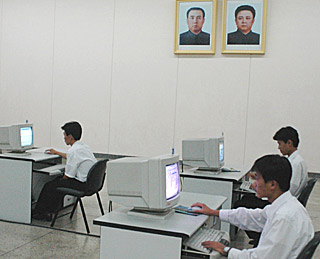 Inside the library, I was given a glimpse of the world’s only
internet - or inter-not. At rows of terminals, dozens of young Koreans used a search engine
that looks just like Yahoo or Google, but yielded radically different results.
Inside the library, I was given a glimpse of the world’s only
internet - or inter-not. At rows of terminals, dozens of young Koreans used a search engine
that looks just like Yahoo or Google, but yielded radically different results.
Kwangmyong (light) is an intranet system, safely sealed-off from the real net. Yet that could come soon, said Gunter Unterbeck, a German working in partnership with the state Korean Computer Center. Unterbeck awaits approval but already his firm offers fast connections by satellite to foreign aid groups and embassies.
Connecting to the net may take some time for suspicious officialdom, but I saw plenty of sign that the population had already evolved. Take Mr. Kim. He wore tinted glasses and spiffy outfits bought in China. My other guide – I have two, plus a driver – favored bright suits, yellow or pink, a big change from the bleak Mao-style gear of my last visit. She was also keen to discuss world affairs, rock bands, and Michael Jackson’s sex-change operation.
For all the stumbling, both seemed forward-thinking, eager to engage the world, like the new class that emerged in the 1990s in China. Soon, they were asking my opinion of George Bush and the Axis of Evil. Nothing remotely as candid occurred on my last visit. I cannot explain Bush or the Axis, but one thing is sure, North Korea is one place John Kerry would surely have carried.
As for the rest, I came to few conclusions. Eight days don’t really amount to much, not in a mysterious land that goes to such extremes to remain so. Like all visitors, I went nowhere without guides, all my movements were controlled, and contact with North Koreans minimal.
 Everything was arranged, not
just where I slept and the food I ate, but all the people I met, including the
busload of locals trucked to a distant waterfall for my benefit.
Everything was arranged, not
just where I slept and the food I ate, but all the people I met, including the
busload of locals trucked to a distant waterfall for my benefit.
Absurd? What else to think? For three hours, we drove deserted roads, past lines of pitifully-shabby people; the real cast in North Korea’s tragic sit-com. Everyone was walking, lugging heavy goods, sacks of dirt or cement, stacks of sticks.
On their backs. Every few miles, groups of soldiers appeared, boys really, filling potholes, pulling rocks by hand from the dirt.
There were no tractors or machines of any kind, just a couple handmade wooden carts hitched to the odd cow. Animals were noticeably scarce. Likewise cars or other travelers.
Yet, at the waterfall, a group of North Koreans seemed to materialize. And they didn’t mind me taking their pictures, unlike all the locals who complained to Mr. Kim on rare instances when I attempted candid shots. It was picture-perfect, until I recalled the bus in the parking lot, filled with the only passengers of the day.
Another day, I visited a huge, ancient Buddhist monastery that didn’t exist on my last visit. Nearby, International Friendship Exhibition displayed tens of thousands of gifts given to the Leaders, Great and Dear. Only before, Junior had no museum, so the same gifts had been given to dad. And Great Leader’s first wife, Junior’s mother, had become a state hero almost of equal status, creating a North Korean Holy Trinity - father, son and Great Mum.
At times, it all seemed too much, this huge socialist Disneyland. That was my feeling at one final visit, denied during my previous tour, with the Great Leader himself.
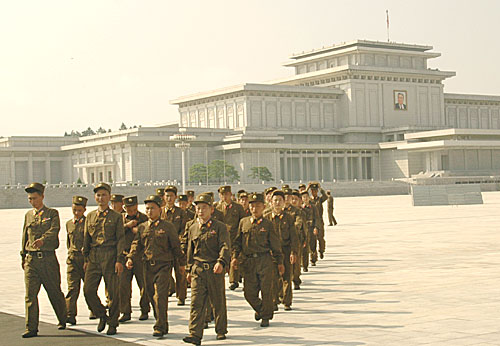 I queued for hours at Kumsusan Memorial Palace, eventually
gliding over a series of escalators through miles of marble, all attesting to
the leader’s greatness, resting in a state grander than all the others I had
seen: Mao in Beijing, Ho in Hanoi and Stalin in Moscow. Issued a music player
and headphones, I could relive the broadcasts and mourning on the day the Great
Leader died.
I queued for hours at Kumsusan Memorial Palace, eventually
gliding over a series of escalators through miles of marble, all attesting to
the leader’s greatness, resting in a state grander than all the others I had
seen: Mao in Beijing, Ho in Hanoi and Stalin in Moscow. Issued a music player
and headphones, I could relive the broadcasts and mourning on the day the Great
Leader died.
Yet this was the rare instance where no historical revision was required. I could see the reverence and sadness on the faces of North Koreans. Change may come slow, impatience grow. But predictions of regime change come from London or Seoul. Where they cannot see the tears of adulation rolling down real cheeks.
Ron Gluckman is an American reporter based in Hong Kong, who roams around the nether reaches of Asia for a variety of publications, including the Far Eastern Economic Review, which ran this story in early 2005.
To return to the opening page and index
push here
[right.htm]
